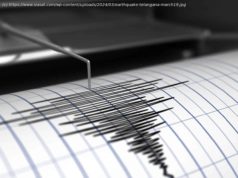 — Japanese scientists have revealed a third major element that makes up the core of the Earth, along with iron and nickel. The search for the third element has been underway for several years. San Fransisco — Japanese scientists have revealed a third major element that makes up the core of the Earth, along with iron and nickel. The search for the third element has been underway for several years. The theoretical breakdown of the Earth’s core: Iron – 85 percent Nickel – 10 percent Silicon – 5 percent With the new experiment, the researchers, who are based at University of Tohoku, believe they will gain a better understanding to how the Earth was formed. The findings may help unravel a debate within science as to whether oxygen was in abundance when the Earth was formed or in limited supply. The reason for recreating the conditions of the Earth’s core within a laboratory setting are because the innermost part of the planet is a solid ball, with a radius of about 1,200 kilometers, which means that it lies too deep to investigate. Most data relating to the core comes from seismic readings. Further studies will need to be run in order to confirm the findings. At present the laboratory studies provide a window to see what the Earth’s interior was probably like after it first formed some 4.5 billion years ago. The findings have yet to be published in a peer review paper. However, Professor Ohtani has The ‘discovery’ of the third element remains theoretical and it is based on studies that recreated the high temperatures and pressures within the core of the Earth. These experiments reveal the ‘missing’ third element to be silicon. The findings suggest that around five percent of the Earth’s inner core is made up of silicon (by weight). This is unlikely to be in a pure form, but rather dissolved into the iron-nickel alloys. Silicon is a hard and brittle crystalline solid with a blue-gray metallic luster. Silicon is the eighth most common element in the universe by mass. However, perhaps until now, it very rarely occurs as the pure element in the Earth’s crust. Elemental silicon plays a significant role in the modern world economy. With the new experiment, the researchers, who are based at University of Tohoku, believe they will gain a better understanding to how the Earth was formed. Speaking with BBC Science , the chief scientist, Eiji Ohtani said: “we believe that silicon is a major element.”The findings may help unravel a debate within science as to whether oxygen was in abundance when the Earth was formed or in limited supply. The reason for recreating the conditions of the Earth’s core within a laboratory setting are because the innermost part of the planet is a solid ball, with a radius of about 1,200 kilometers, which means that it lies too deep to investigate. Most data relating to the core comes from seismic readings. Further studies will need to be run in order to confirm the findings. At present the laboratory studies provide a window to see what the Earth’s interior was probably like after it first formed some 4.5 billion years ago. The findings have yet to be published in a peer review paper. However, Professor Ohtani has presented his research to the Meeting of the American Geophysical Union in San Francisco.
— Japanese scientists have revealed a third major element that makes up the core of the Earth, along with iron and nickel. The search for the third element has been underway for several years. San Fransisco — Japanese scientists have revealed a third major element that makes up the core of the Earth, along with iron and nickel. The search for the third element has been underway for several years. The theoretical breakdown of the Earth’s core: Iron – 85 percent Nickel – 10 percent Silicon – 5 percent With the new experiment, the researchers, who are based at University of Tohoku, believe they will gain a better understanding to how the Earth was formed. The findings may help unravel a debate within science as to whether oxygen was in abundance when the Earth was formed or in limited supply. The reason for recreating the conditions of the Earth’s core within a laboratory setting are because the innermost part of the planet is a solid ball, with a radius of about 1,200 kilometers, which means that it lies too deep to investigate. Most data relating to the core comes from seismic readings. Further studies will need to be run in order to confirm the findings. At present the laboratory studies provide a window to see what the Earth’s interior was probably like after it first formed some 4.5 billion years ago. The findings have yet to be published in a peer review paper. However, Professor Ohtani has The ‘discovery’ of the third element remains theoretical and it is based on studies that recreated the high temperatures and pressures within the core of the Earth. These experiments reveal the ‘missing’ third element to be silicon. The findings suggest that around five percent of the Earth’s inner core is made up of silicon (by weight). This is unlikely to be in a pure form, but rather dissolved into the iron-nickel alloys. Silicon is a hard and brittle crystalline solid with a blue-gray metallic luster. Silicon is the eighth most common element in the universe by mass. However, perhaps until now, it very rarely occurs as the pure element in the Earth’s crust. Elemental silicon plays a significant role in the modern world economy. With the new experiment, the researchers, who are based at University of Tohoku, believe they will gain a better understanding to how the Earth was formed. Speaking with BBC Science , the chief scientist, Eiji Ohtani said: “we believe that silicon is a major element.”The findings may help unravel a debate within science as to whether oxygen was in abundance when the Earth was formed or in limited supply. The reason for recreating the conditions of the Earth’s core within a laboratory setting are because the innermost part of the planet is a solid ball, with a radius of about 1,200 kilometers, which means that it lies too deep to investigate. Most data relating to the core comes from seismic readings. Further studies will need to be run in order to confirm the findings. At present the laboratory studies provide a window to see what the Earth’s interior was probably like after it first formed some 4.5 billion years ago. The findings have yet to be published in a peer review paper. However, Professor Ohtani has presented his research to the Meeting of the American Geophysical Union in San Francisco.






